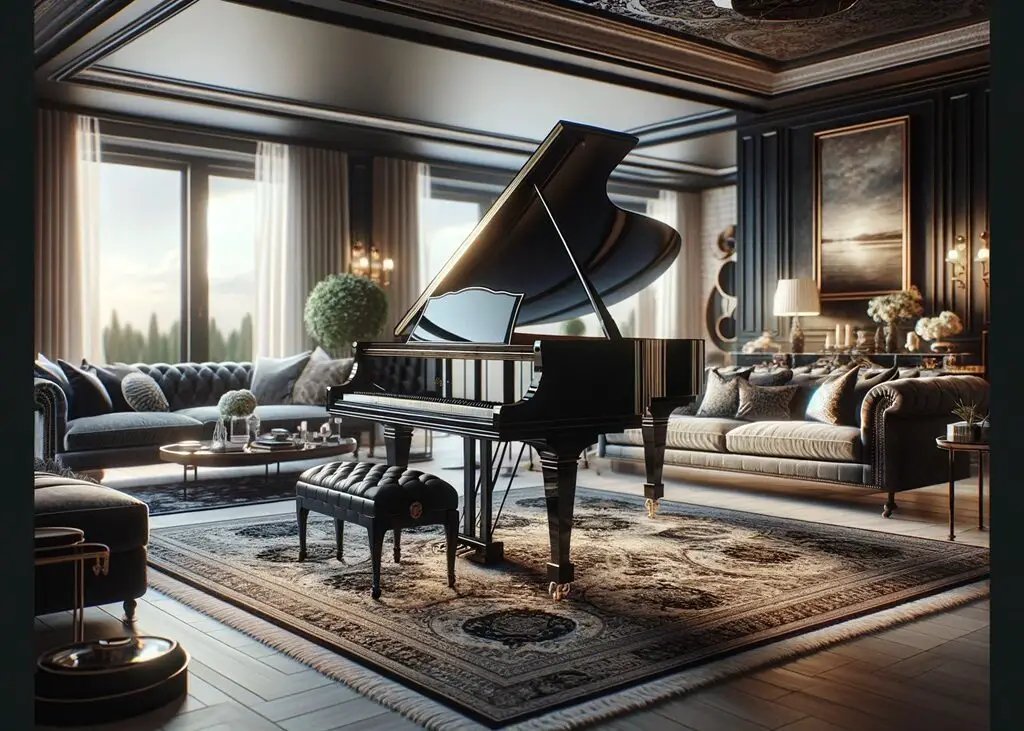Wondering what to know before buying a piano? This article is designed to guide you through the essential factors and considerations, ensuring you make a well-informed decision that aligns with your needs and preferences.

Table of Contents
What to Know Before Buying a Piano: Understanding Your Needs
Before diving into the world of pianos, it’s important to assess your needs. Think about your space, the kind of music you wish to play, and your skill level. This initial assessment will steer your decision-making process in the right direction.
Acoustic vs. Digital Pianos
One of the first decisions you’ll face in your piano-buying journey is choosing between an acoustic and a digital piano. This choice depends largely on your personal preferences, space, budget, and musical needs.
Acoustic pianos are known for their rich, resonant sound and traditional feel. They work by hammers striking strings, producing vibrations that are amplified through the piano’s body.
This mechanical process gives acoustic pianos a unique tonal quality and dynamic range that many musicians cherish. However, they do require regular tuning and maintenance to keep them sounding their best.
Additionally, acoustic pianos are generally larger and heavier, making them less portable and requiring more space in your home. They can be a significant investment, both in terms of cost and space.
On the other hand, digital pianos offer a more modern approach. They are electronic instruments that reproduce piano sounds digitally.
One of the main advantages of digital pianos is their portability. They are typically lighter and more compact than acoustic pianos, making them a great option if you have limited space or if you need to move the instrument regularly.
Digital pianos require less maintenance, as there are no strings to tune and no hammers to regulate.
Moreover, digital pianos often come with a variety of sound options and features. Many models can mimic the sounds of different types of pianos and other instruments, which can be a significant advantage for those looking to explore a wide range of musical styles.
They also often include built-in learning tools, recording capabilities, and connectivity options for headphones and amplification systems, making them a versatile choice for both practice and performance.
It’s also worth noting that the touch and feel of the keys can differ between acoustic and digital pianos. Acoustic pianos typically have a heavier, more responsive touch, which can be beneficial for developing finger strength and technique.
Some digital pianos, however, now offer weighted keys that aim to replicate the feel of an acoustic piano’s keyboard.
Size and Space Considerations
When purchasing a piano, space is a significant factor that should be carefully considered. Before making a decision, it’s essential to measure the area where you plan to place the piano.
This step is not just about ensuring the piano fits; it’s also about considering the acoustics and the environment where the piano will be used.
Acoustic pianos, especially grand pianos, can be quite large and require a significant amount of space. Not only do you need to account for the size of the piano itself, but also for additional space around it.
This is important for the sound to resonate properly and for ease of movement for the player. Ensure you have adequate space for the piano and its bench, and also consider the room for the pianist to sit comfortably and move freely while playing.
The environment where the piano is placed is equally important. Pianos should be placed in a room where temperature and humidity are relatively stable, as extreme fluctuations can affect the tuning and longevity of the instrument.
Avoid placing the piano near windows, doors, or vents where it can be exposed to direct sunlight, drafts, or heat sources.
For smaller spaces, upright pianos might be more suitable. They take up less floor space as their height, rather than their length, provides the necessary resonance chamber.
Digital pianos are even more versatile in terms of placement. They are compact and can fit into smaller spaces more easily.
Furthermore, since they are not affected by environmental factors like humidity and temperature, they offer more flexibility in placement.
In addition to the piano itself, consider the acoustics of the room. A room that is too small or overly furnished might absorb too much sound, while a room that is too large or sparsely furnished might cause the sound to echo. The ideal space will complement and enhance the piano’s sound.
Remember, the goal is to integrate the piano harmoniously into your living space. It should be placed in a way that enhances both its playability and the aesthetic of the room.
Taking the time to carefully consider size and space will ensure that your piano not only fits physically but also suits your lifestyle and your home.
Budgeting for Your Piano
When planning to buy a piano, setting a realistic budget is a critical step. Pianos can vary greatly in price, ranging from a few hundred dollars for basic models to tens of thousands for high-end or grand pianos.
Therefore, it’s important to establish a budget that not only considers the initial purchase price but also accounts for potential ongoing costs.
For acoustic pianos, ongoing costs can include tuning, repairs, and maintenance. Regular tuning is essential to keep a piano sounding its best, and this can be a recurring expense typically required at least once or twice a year.
Repairs and maintenance costs can vary depending on the age and condition of the piano. It’s wise to allocate a portion of your budget for these potential expenses, especially if you’re considering a used or older piano.
In contrast, digital pianos generally have lower ongoing costs. They don’t require tuning, and repairs are often less frequent and less costly.
However, you may still want to consider the cost of accessories such as headphones, amplifiers, or additional software, which can enhance your playing experience.
When setting your budget, also think about the long-term value of the piano. A higher-quality instrument might be more expensive initially but can offer better longevity, sound, and playing experience. It can also be a valuable investment if you’re planning a long-term commitment to playing.
Try Before You Buy
It’s essential to play the piano before making a purchase. This hands-on experience allows you to feel the action of the keys and hear the tone of the instrument, which are crucial to your playing experience.
The action of the keys, or how the keys respond when pressed, can vary significantly between different pianos.
Some keyboards may feel heavier or lighter, and the responsiveness can affect your ability to play certain pieces of music or to express yourself musically. Trying out the piano firsthand lets you assess whether the touch suits your preference and playing style.
Hearing the tone of the piano is equally important. Each piano has its unique sound, and what might be pleasing to one person could be less so to another.
Listen to the richness of the sound, the clarity of the notes, and the sustain of the tones. Playing a variety of notes and chords will give you a better understanding of the piano’s overall sound quality.
If you’re not confident in your ability to assess a piano, consider bringing along a more experienced pianist or a piano teacher. They can help you evaluate the instrument’s quality and suitability for your needs.

Research Brands and Models
When embarking on the journey of purchasing a piano, doing thorough research on different brands and models is imperative. The market offers a wide array of options, each with its unique characteristics and qualities.
Begin by reading reviews and product comparisons online to get a sense of the most respected and reliable brands. Look for feedback on aspects such as durability, sound quality, key action, and overall value.
Additionally, talking to experienced pianists or piano teachers can provide invaluable insights. They can share their personal experiences with different brands and models, offering advice on what to look for based on your individual needs and preferences.
Music schools, piano dealerships, and local musician communities can also be excellent resources for gathering information.
When researching, pay attention to the specific features of each model. For acoustic pianos, consider the type of wood used, the string quality, and the craftsmanship of the instrument.
For digital pianos, look into the sound technology, the variety of tones, the touch response of the keys, and any additional features like recording capabilities or connectivity options.
Consider Second-Hand Options
If you’re working with a tight budget, considering a second-hand piano can be a practical choice. Many high-quality pianos are built to last and can maintain their value and functionality for decades if well-maintained. However, it’s crucial to inspect a used piano thoroughly before making a purchase.
When inspecting a second-hand piano, check for any signs of damage or excessive wear. This includes checking the keys, pedals, strings, and soundboard.
Play each key to ensure they work smoothly and listen for any unusual sounds or inconsistencies in tone. Examine the piano’s exterior for any cracks or damage that could affect its structure and performance.
Bringing along someone knowledgeable, such as a piano technician or an experienced pianist, can be extremely beneficial.
They can provide a more technical evaluation of the piano’s condition, including checking for issues that might not be immediately apparent, such as internal damage or the need for major repairs.
What to Know Before Buying a Piano: Warranty and After-Sales Service
When investing in a piano, understanding the warranty and after-sales service options is as crucial as the instrument’s quality and features.
A good warranty can provide peace of mind, saving you from unforeseen expenses in case of defects or issues with the piano after purchase.
Firstly, examine the warranty length and coverage. Warranties for new pianos can vary significantly between manufacturers and models.
Some may offer limited warranties that only cover specific parts or types of damage, while others might provide more comprehensive coverage.
For acoustic pianos, check if the warranty covers critical components like the soundboard, strings, and action mechanism. For digital pianos, the warranty might include coverage for electronic components and the keyboard.
Also, consider the reputation and reliability of the manufacturer’s customer service. A responsive and helpful customer service team can make a significant difference, especially if you encounter any issues with your piano.
Look into the manufacturer’s or retailer’s policies regarding repairs and maintenance. Are these services easily accessible, and does the company have a track record of timely and effective support?
For second-hand pianos, warranty options can be limited. If you’re buying a used piano from a dealer, inquire if they offer any warranty or guarantee, even if it’s for a shorter duration.
If purchasing from an individual, the likelihood of a warranty is low, but you can still ask about the piano’s history and any services or repairs it has undergone.
Additionally, some piano retailers offer after-sales services such as tuning, technical support, and maintenance advice. These services can be valuable, particularly for new piano owners who are still familiarizing themselves with the instrument’s care and maintenance needs.
For more articles on piano questions, click here: Piano Questions: Your Ultimate Guide to Understanding All About Pianos
Conclusion: What to Know Before Buying a Piano
Purchasing a piano is a significant investment, and being well-informed is key. By considering these points, you can make a choice that brings you joy and satisfaction for years to come.